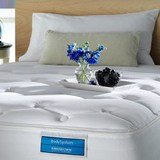Queen Mattress Dimensions
Queen Mattress Sizes According to Country
Everything you've always wanted to know about queen mattress dimensions is right here! You'll learn a bit about the history of beds along with the varying standard sizes of queen size mattresses.
Most countries have established their own standards for bed sizes. The names of the bed sizes can vary a bit too. This information could come in handy if you're traveling on vacation to another country and would like to book a queen-size bed for your stay.
Bed Size
The term bed size refers to the mattress size, not the frame of the bed. Although bed frames, headboards, and footboards can be very different from each other in size, appearance, and price, beds are sold based on the size mattress they will accommodate. Once you've purchased your specific mattress and have your queen mattress dimensions in hand, then you're ready to shop for a bed frame that will fit your mattress properly.
What Are Queen Mattress Dimensions Around the World?
- Americas, New Zealand, and Australia - queen size standard is 60x80 inches
- Latin America and Continental Europe - queen size is 63x79 inches
- Norway - queen size is equal to 2 single or twin mattresses at 60x79 inches
- United Kingdom and Ireland - queen size mattresses are also called standard doubles and are 60x78 inches
A California queen, most often found in the U.S., is 60 inches by 84 inches, offering more length for taller individuals. Simmons, a mattress manufacturer in the U.S., makes an Olympic/Expanded Queen size bed that is 66x80 inches. It's primarily a novelty bed.
When shopping for a queen size mattress, be sure to check the specifications for each individual mattress because there are some manufacturers that will make mattresses that are an inch longer or an inch shorter than the established standard size queen mattress.
A good warranty for a queen size mattress is a minimum of 10 years.
Quick Facts About Queen Mattresses
- A queen mattress that is 60 inches wide by 80 inches long measures a whopping 5 inches longer and 6 inches wider than a double or full size mattress
- Couples sleeping on a queen mattress sized 60x80" have roughly 30 inches of sleeping space each
- Queen beds are an excellent size for single sleepers who tend to move around a lot or tend to sprawl across their sleeping space
- Traditionally, queen beds are purchased for guest rooms, bed and breakfast establishments, or average size master bedrooms
- Sleeping alone on a twin size mattress gives you 9 more inches of sleeping space than a queen mattress with dimensions of 60x80 inches
- Queen mattress dimensions in length are the same as a king size bed
- A queen size mattress measuring 60x80 inches yields 4800 square inches of sleeping area
- Queen size beds are a better choice for couples than a full size bed in terms of space allowance
- Given the dimensions of a queen size mattress, a bed frame for this size mattress must feature a central support of some kind in addition to the typical rectangular bed frame
History of Beds
Thousands of years ago, people slept on the ground or primitive beds they created. By 3400 B.C., royalty found that raising the bed or pallet off the ground was more comfortable. Commoners created soft sleeping spaces directly on the ground using tree boughs.
It shouldn't come as a surprise that the Roman Empire boasts the first bed with a mattress. The mattress was filled to overstuffing with feathers, hay, wool, or reeds found along the river.
During the Renaissance, mattresses filled with straw or other materials were covered in luxurious fabrics like velvet and silk to create an amazing sleeping space.
The 16th and 17th century mattresses were suspended on top of a latticework of rope for comfort. You've heard the expression sleep tight? The ropes would eventually become loose as people slept on them so they would require tightening periodically. That's where this saying came from!
The late 1800s were significant years for beds and mattresses. The first cotton mattresses, first iron beds, and first coil spring mattress were discovered and used.
Fast forward to modern day and we have several different types and sizes of mattresses from which to choose and each is based on our own personal comfort level!
Today, in addition to "regular" mattresses, you can sleep on a futon, waterbed, or air mattress.
Let's All Sleep Better
Help us to spread the word!
Simply copy and paste this code into your Facebook page or blog. Thank you for sharing!



New! Comments
Share your thoughts about what you just read! Leave me a comment in the box below.